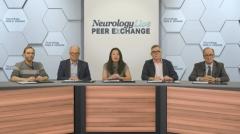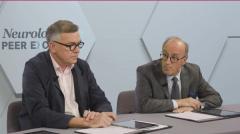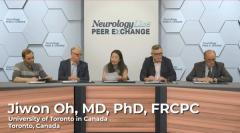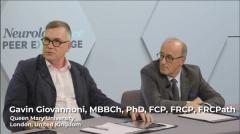
BTKi Treatment: Clinical Measures
Experts provide insights about what clinical measures they look for when treating patients with BTKis for multiple sclerosis.
Episodes in this series

Jiwon Oh, MD, PhD, FRCPC: Can I ask, what clinical measure would you need to see to be convinced that these BTK inhibitors have an effect on central compartmentalized information?
Gavin Giovannoni, MBBCh, PhD, FCP, FRCP, FRCPath: Well, I think, I mean, personally I would want to see the MRI metrics on the end organ, so I'd like to see that there’s a substantial slowing down of brain volume loss, because I think that integrates, that’s for me, the MRI metric that I want to see, because then you can at least allow you to compare to our existing disease-modifying therapies. But from a clinical perspective, I want to see a dissociation between MRI and clinical relapses and disability progression. We know that with the B-cell–depleting therapies, for example, they’re incredibly good at switching off relapses and MRI activity, and I’ll put them in the moderate zone in terms of brain volume loss reduction and disability progression. Just another example, teriflunomide is not that good at suppressing MRI activity and relapses, but it seems to be pretty good at slowing down brain volume loss and disability progression.
So you’d want to see something like that with this class of drugs. And I would want it to be, I’m just going to try and give you a percentage. So the B-cell depleters are around the 30% to 35% mark relative to an active comparator, be it interferon or teriflunomide. I’d want to see a figure of over 50%. Can I be that provocative? Would you want to see disability progression over 50%? The answer versus teriflunomide?
Patrick Vermersch, MD, PhD: Maybe the key point is all these biomarkers, the use of these biomarkers to demonstrate it will be clinically meaningful. It will be very hard to demonstrate that, for sure. For a clinician, probably we will need to use some composite scores for the assessment of what is really visible—not only EDSS but working capacities, capacity of the upper limbs—but also the invisible part, cognition. Also, some patient-reported outcomes possibly adding value in this area.
I think now we need definitely to use more patient-reported outcomes to evaluate this impact of subtle changes related to the global concept of PIRRA. But PIRRA is a P for progression, how to evaluate this progression with such drugs acting in the CNS, I think it’s a key point.
Gavin Giovannoni, MBBCh, PhD, FCP, FRCP, FRCPath: I don't think the trials have PIRRA as an outcome measure, do they? What are the exploratory outcomes?
Jiwon Oh, MD, PhD, FRCPC: As one of the exploratory? This question has been asked before, and yes, I think it is, because you can, I mean, you can measure it just for the EDSS, but it’s not one of the primary or secondary endpoints.
Gavin Giovannoni, MBBCh, PhD, FCP, FRCP, FRCPath: It’ll be the first time we actually have it as a preplanned analysis, because most of the PIRRA papers have been post hoc analysis. So this is actually, as part of the statistical analysis plan, it’d be quite reassuring if we did see an impact on PIRRA, which is a composite, really.
Krzysztof Selmaj, MD, PhD: So Gavin talking about the enhancement of remyelination repair and recovery, and talking about the outcomes and how we can measure it. So, would you consider the improvement in clinical scores? Yeah, yeah. So, yeah, that’s the final outcome, too, because, you know, we all have all these biomarkers. We know they’re fine. We can make a cross-check with MRI, everything. But I think the final thing, we need to see some final clinical effect with patients.
Gavin Giovannoni, MBBCh, PhD, FCP, FRCP, FRCPath: That would be that. There’s not a single disease-modifying therapy that’s got that into the label. So, and I'm not, I’ve got to look at the hierarchy of outcomes. If disability improvement is in the secondary outcomes, then maybe we could see it get into a label if it does have a significant impact.
Amit Bar-Or, MD, FRCPC: What I was going to add is it's not necessarily an influence on the label, at least not in the short term. But I liked your comment, Gavin, about not necessarily being able to hang your hat on a single measure, but on the relative impact on different measures that may be reporting on relapse biology versus relapse-independent biology. And one of the areas of advance in the field relates, of course, to fluid biomarkers. Glial fibrillary acidic protein (GFAP) today is where neurofilament light chain (NFL) was maybe 3 to 4 years ago, but there’s already some sense that GFAP may report somewhat more than NFL, specifically on nonrelapsing progressive disease. Chitinase-3-like protein 1 (YKL-40), another molecule, there are several that may be with emerging data that will help us to some extent, at least on average, identify combinations of molecules that track better with relapse biology and drugs that impact relapse biology versus ones that may be more related to nonrelapsing biology and the relative impact of any therapeutic, particularly Bruton tyrosine kinase (BTK) inhibitors. I would hope to see a shift in the balance.
Patrick Vermersch, MD, PhD: Also, let me come back to the biomarkers you mentioned—neurofilament and GFAP. We have a couple of data points already with BTK inhibition. And of course, it’s good. We observe a decrease—GFAP and neurofilament. However, the data are not so impressive. I would like to say, I don’t know, perhaps a threshold is not possible to go below. I don't know, but if we look, if we compare, it’s an indirect comparison, it’s not really scientific, but if we compare with data we have on neurofilament and GFAP with other previous highly active treatments, maybe with the data we have today, it’s not so impressive. I don’t know your opinion about that.
Amit Bar-Or, MD, FRCPC: Well, I think, for NFL I think that is probably a fair conclusion and perhaps still in keeping with the expectation that BTK inhibitors will have a perhaps lesser efficacy, although I think some of the BTK inhibitors are emerging as probably classifiable in the high-efficacy range. The question with GFAP is, I think, a little bit more complicated. To date, there are some studies that report good correlation or sufficient correlation between cerebrospinal fluid and serum GFAP and results of serum GFAP in relation to other clinical outcomes, but not all studies do that. And again, I think GFAP, we still need to improve measurement methods and the specificity of the measurement, and the abnormality may be at a level that is somewhat less responsive to change. And that might be one of the contributors, at least to date, explaining why GFAP has not emerged as informative as NFL for the biology that NFL captures.
Gavin Giovannoni, MBBCh, PhD, FCP, FRCP, FRCPath: I mean, one of the things we must not fall into is this monotherapy thinking, because I’m starting to think that maybe the best place for BTK inhibitors is not as first-line monotherapy but as an induction and maintenance strategy—using BTK inhibitors as second-line therapy after a period of B-cell depletion. That would allow repopulation of the B-cell compartment in the presence of a BTK inhibitor. Maybe that’s the best use of BTK inhibitors. So I’m hoping that if these trials are positive and the drugs come to market, we can start those studies as soon as possible, because I actually think the best place for these will be as maintenance therapy, with induction using anti-CD20.
Amit Bar-Or, MD, FRCPC: I’m a fan of that idea as well, Gavin. I don’t think it excludes potential monotherapy use, but I like that idea of serial treatment. And one of the reasons is that while we initially thought BTK inhibition acted on B cells by inhibiting their activation so they can’t do harmful things, BTK inhibition actually does not just decrease activation—it seems to modulate the functional response profile. So those cells can still respond, but in many contexts they’re less proinflammatory and may even be partially anti-inflammatory. Therefore, B-cell reconstitution after B-cell depletion with BTK inhibition may shift B cells to an even less proinflammatory or more anti-inflammatory phenotype. We’d love to see that experiment done.
Gavin Giovannoni, MBBCh, PhD, FCP, FRCP, FRCPath: I think there’s an NIH study—is it Danny Reich doing a tocilizumab-ocrelizumab trial? Yes, I think it’s about to start. It already started.
Jiwon Oh, MD, PhD, FRCPC: They have some early results. Oh, okay. Yeah, and then they’re measuring the proteome after the switch. And there seems to be a shift—a beneficial shift. But still small numbers, early days. Again, interesting data accumulating that seems to support a plausible mechanism.
Krzysztof Selmaj, MD, PhD: Because when you talk about combination B-cell depletion with BTK inhibition, another suggestion from immunology is to use them together. BTK inhibition increases lymphocyte egress from secondary lymphoid organs, providing more cells for anti-CD20 to kill, so the combination could be more efficient. I know it sounds a bit overactive, but in discussing interactions, I think...
Amit Bar-Or, MD, FRCPC: I suppose the question is, how much better can we do for relapse biology? Because we’re already doing pretty well. We may still need...
Krzysztof Selmaj, MD, PhD: It’s not only about relapses, because with CD20 monoclonal antibodies, we also slow progression. So it’s not only about relapses; when you kill enough autoimmune B cells, you’d expect almost complete prevention of relapses but also slowing of progression. I think our challenge is still to interpret what the impact on progression actually means—is it relapse biology–related underneath or independent?
Gavin Giovannoni, MBBCh, PhD, FCP, FRCP, FRCPath: I wanted to go back to safety, because one thing we didn’t discuss—most of these trials were during the COVID-19 pandemic, and we had a large number of people on these agents get COVID-19. Reassuringly, they seemed to handle infection relatively well, with no higher mortality or morbidity signal. So their immune systems seem relatively intact for fighting infections. The incidence of hypogammaglobulinemia also doesn’t seem as high as with anti-CD20 long-term. That’s reassuring because low immunoglobulin G is a risk factor for infections.
Krzysztof Selmaj, MD, PhD: Regarding infections and COVID, there’s a double-hit phenomenon because BTK is involved in many immune cells, including anti-inflammatory activity. So BTK inhibitors may also suppress some inflammation and thereby have a milder effect on infections.
TRANSCRIPT EDITED FOR CLARITY
Newsletter
Keep your finger on the pulse of neurology—subscribe to NeurologyLive for expert interviews, new data, and breakthrough treatment updates.































